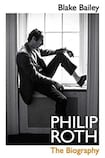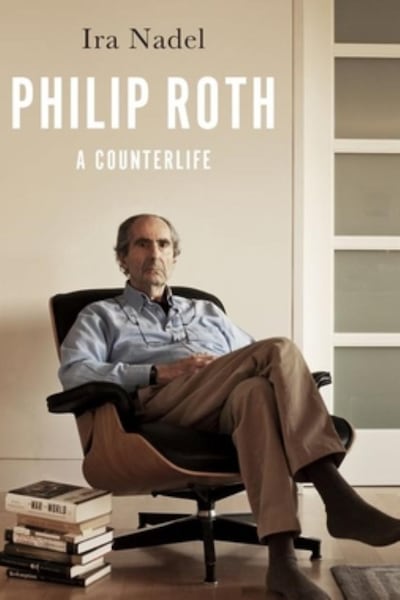
Philip Roth: The Biography
by Blake Bailey
Jonathan Cape, 912pp, £30
Philip Roth: A Counterlife
by Ira Nadel
Oxford University Press, 568pp, $29.95
The first major biography often marks a turning point in the reputation of an artist. Much-loved writers like Roald Dahl and Philip Larkin took a hit when their worst features were exposed – though the work lives on. Perhaps it’s better to get your controversy done with when you’re still alive, as Philip Roth did. We have a strong idea not just from the books but the circumstances of their publication what he was like, and I dived into Blake Bailey’s much-anticipated biography expecting to find what I did: a big, horny genius.
Roth’s twin loves were settled early, at the age of 18 in 1951, as the “tall, good-looking” young man sold Collier’s magazine subscriptions door to door, occasionally invited in by lonely housewives, though only (“to his lasting chagrin”) for a glass of lemonade. Moving to Chicago, he pursued the dream of “bibliography by day, women by night”, preferably in the company of “slight, pretty blondes with brains”, which was a relief after the frustrations of early adulthood: “The erections of 1950,” he later said, “were exactly the same as the erections of 2012, but the erections of 1950 had nowhere to go.”
Beneath this uniquely Rothian patina lies traditional elements of the writer’s story: the teacher who encouraged him, the early writing that worked its way through and out of the influence of Salinger and Capote.
But it was the Jewish novelists of the era that showed Roth the way. His reading of Saul Bellow’s The Adventures of Augie March (1953) taught him “the power of a voice” – Bellow would become his “all-time hero” – and Bernard Malamud’s The Assistant (1957) was “the next clump on the head”, helping Roth recognise that he could write about ordinary Jewish life.
Nonetheless, the desire “to write literature” ran deep, until in a four-week burst in 1958 he wrote the comic novella Goodbye, Columbus, which was published the following year and became an immediate succès de scandale. It was a commercial smash, but by not writing about what Roth called “cute Jews” it drew attacks from Jewish community leaders (“what is being done to silence this man?”), one of whom went on to accuse Roth of retrospectively contributing to the Holocaust, by creating “a conception of the Jews as ultimately led to the murder of six million in our lifetime”.
All writers draw on their experiences for their fiction, but few did it with as much complexity and elan as Roth
But that was nothing to what would follow, after a few stumbles, 10 years later with Portnoy’s Complaint (1969), the book that made him famous again; it was an hysterical (in both senses) paean to masturbation that sought to make Roth’s critics realise that the shmutz wasn’t detracting from the story: “the shmutz is the story!” Portnoy’s advance contributed to Roth earning, in 1968, the 2020 equivalent of $6.1m.
This gave him time, at least, as he continued to lose his way and find it again, with another decade passing before his next great book, The Ghost Writer (1979), which finally began a supercharged period of 20 years of consistent brilliance: the Zuckerman Bound trilogy, the halls of mirrors in The Counterlife (1986) and Operation Shylock (1993), the scabrous erotomania of Sabbath’s Theater (1995) and the mature efflorescence of American Pastoral (1997) and its spiritual sequels.
Aside from anything else, Bailey is an astute literary critic, with a clear-eyed appraisal of the novels, even the misfires such as the “tasteless” Our Gang (1971) and the plain “bad” The Humbling (2009), the penultimate novel which made Roth understand he could be a novelist no longer.
All writers draw on their experiences for their fiction, but few did it with as much complexity and elan as Roth. If the books were the life – he literally wore down the letter I on his Selectric typewriter – then the life was most definitely the books. “The intensity, the intensity,” Roth said of his writing life. “It kills you and it makes you all at once.”
So what do we learn about Roth the man? There are excruciating reports on the decades of back pain, which readers of The Anatomy Lesson (1983) will recognise, and his generosity with money toward others: $25,000 here, $100,000 there. But to what Bailey calls Roth’s “essential magnanimity” we can say, well, up to a point.
One of the clearest traits is a superhuman ability to harbour grudges. In one example, in the late 1990s he hired a handwriting expert to determine the authorship of a scurrilous letter he’d received four years earlier. In another, “Roth brooded about things for a couple of years” before taking action. He even – in his 70s! – urged an acquaintance to ask a dying woman who’d been on the National Book Award judging panel 36 years earlier why Portnoy’s Complaint hadn’t been shortlisted.
Then there are the women, both in his books (one critic identified three types: “cannibals and sponges and rocking chairs”, though Roth’s friend Hermione Lee felt there were, perhaps, four) and in his life. First wife Maggie had by her own account “no conscience,” and her “melancholia and its various harrowing forms” gave neither of them happiness: though Roth got three books out of it, one way or another.
More complicated is his second marriage to Claire Bloom, who declined to be interviewed for the biography, though Bailey quotes frequently and at length from her memoir, Leaving a Doll’s House. Roth’s writing ethic (“the idea that you don’t have to work all the time – that’s news to me”), which gave us 31 books, meant he was “a holy terror to live with if I haven’t been writing steadily”.
The charge of misogyny was one that Roth resented throughout his life, and many of his ex-girlfriends remained friends with him, but there’s no hiding from something in his view of women when you look at his later partners, from Sylvia (30 years his junior) to Lisa Halliday and Birgit (both 43 years his junior). Susan Rogers, the daughter of friends and three decades younger than Roth, was rejected as “too old.” (At least he had finally lived up to the ideals of his hero Saul Bellow.)
Perhaps the best summary of the position is in New York magazine’s 2012 survey of writers who were asked “Is Roth a misogynist?” to which, as Bailey reports it, “17 percent said yes, 30 percent no, and 52 percent ‘Well…’”

And if Bailey’s humane and thorough account of Roth, delivered in a witty, wry and even self-deprecating style isn’t impressive enough, then it stands all the higher in comparison to Ira Nadel’s pointedly titled Philip Roth: A Counterlife. This shares with Bailey’s book many of the known elements of Roth’s life, but the style is flat and second-hand, with a bizarre inability to see the wood for the trees. (“Music also had a minor role in the home. Although they did not have a record player, Bess and Herman were expert whistlers…”)
You can’t fault Nadel’s attention to detail, but the results – listing together all the scenes in Roth’s novels set in cemeteries, say – are more like a concordance than a biography. It lacks the spark of life that animates Bailey’s Roth, which I finished reading through tears. I had a similar experience with Nadel, but for different reasons.











